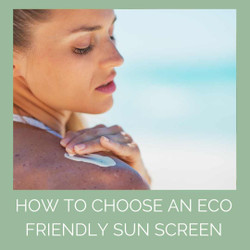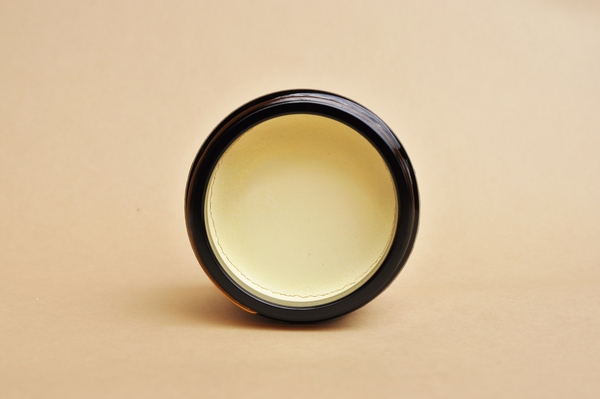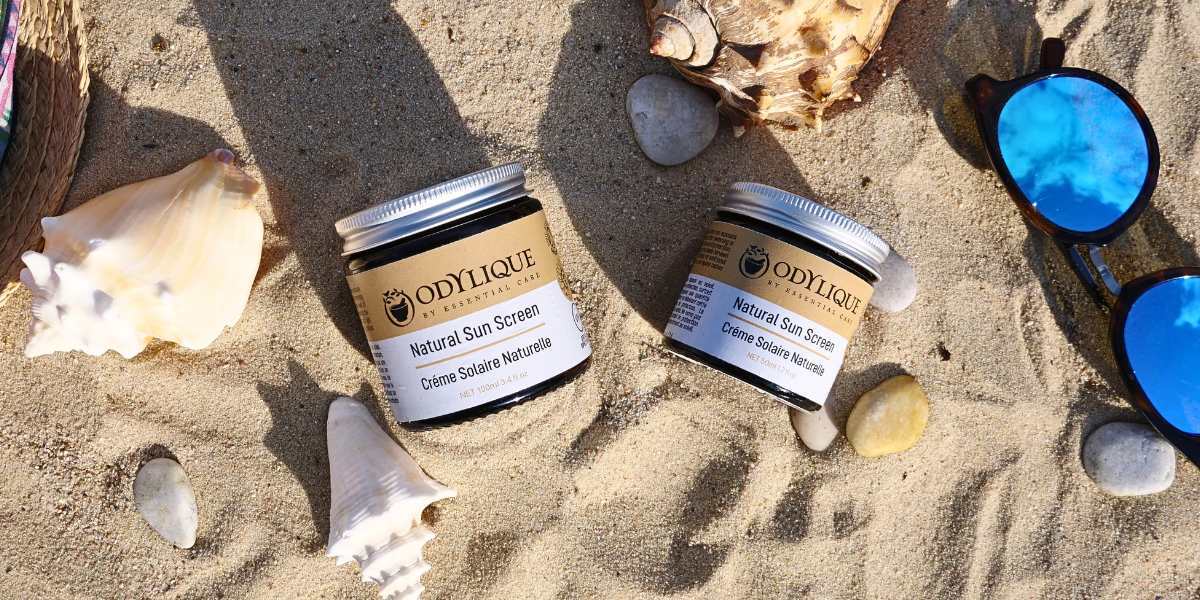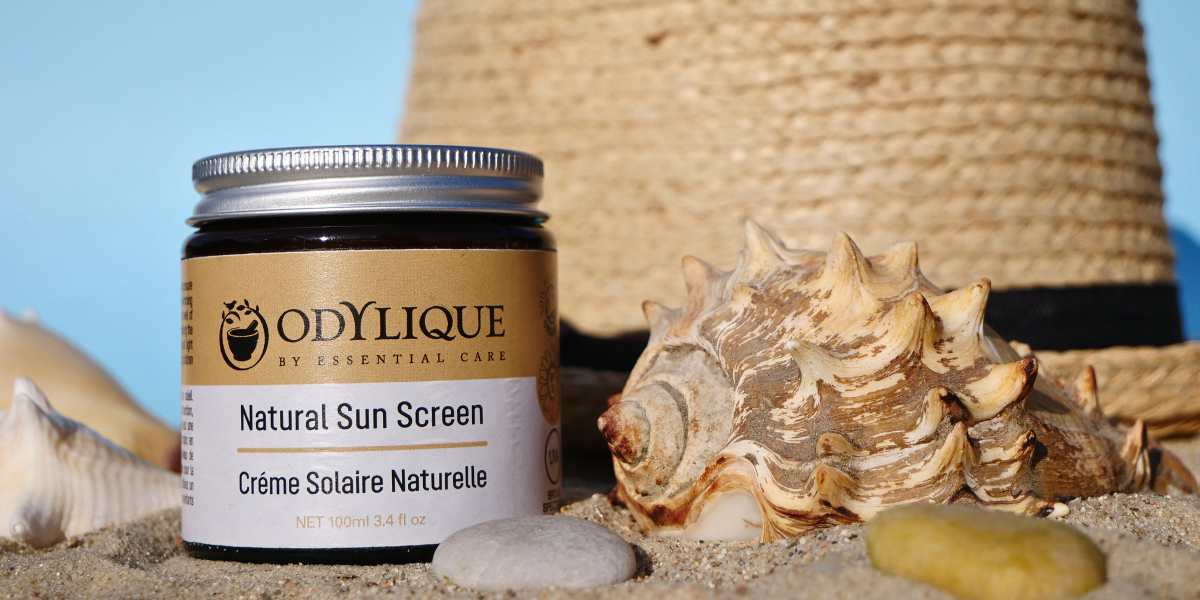Sunscreens are not all made equal.
Broadly speaking there are two types of sunscreen ingredient – mineral and ‘chemical’, but their impact on the environment can be very different. Which is the more eco friendly sunscreen; mineral or chemical?
Firstly, let’s sort out some definitions:
What is a Mineral Sunscreen?
To be sure, when we talk about mineral sunscreen, we mean one that uses zinc oxide, and often also titanium dioxide to protect you from the sun. Mineral sunscreen is also known as physical sunscreen . These minerals form an incredibly thin, physical shield on your skin, that deflects the sun’s rays.
What is a Chemical Sunscreen?
‘Chemical’ or more accurately, synthetic sunscreen works by absorbing into your skin and ‘neutralising’ the damaging effect of ultraviolet radiation. Common synthetic sunscreen ingredients are avobenzone, octocrylene, homosalate, oxybenzone and PABAs.
Chemical sunscreens aren’t of course called that on the label – you’ll typically see something like ‘sun filter technology’, or nothing at all. In fact, if it doesn’t say mineral sunscreen, the chances are that it mainly uses the synthetic ingredients to protect you.
Which Type of Sunscreen Is More Eco Friendly?
Generally speaking, it is the mineral sunscreens that are better for the environment . Zinc oxide and to an extent, titanium dioxide, are recognised as being less harmful to our waterways.
Many of the chemical sunscreens are just not eco-friendly. Let’s take a look at some specifics.
Chemical Sunscreen Ingredients That Pollute:
Ethyl hexylsalicylate (octisalate):
A chemical UV filter, this is a known environmental toxin and may harm aquatic life.
Paraffin liquidum or mineral oil:
These ingredients are petroleum bi-products and used as ‘moisturisers’ in some sunscreens. While the amount washed off swimmers into the sea is unlikely to be a true oil slick, any is undesirable.
Octinoxate:
When this sun filter enters our waterways, it can be toxic to any aquatic life or animals that absorb or consume it. Octinoxate accumulates in tissues and is a known hormone disruptor in animals.
Oxybenzone:
Evidence has revealed damage to coral reefs when this chemical is washed off of swimmers (NOAA 2015).
Retinyl Palmitate:
Retinyl, or vitamin A1, is an antioxidant that occurs naturally in foods but retinyl palmitate is artificial. It is often used in sun products and can be toxic to the environment.
This is not an exclusive list of polluting sun filters. And what makes things tricky is that some sunscreens advertised as ‘mineral’ also contain the chemical filters.
How Do I Make Sure My Sunscreen is Eco Friendly?
Unfortunately, most sunscreens are not perfect from an eco-friendly perspective, with even the mineral sunscreens being toxic to aquatic life in large quantities. However, the non-mineral sunscreens usually contain a cocktail of chemicals that are proven to be damaging. The mineral sunscreen filters are much preferable from a human health perspective and a certified organic sunscreen will contain ingredients grown in a sustainable way.
Look for a reef-safe mark and make sure it is a real certification - not one that a brand has made up (this does happen).
The good news is that there are many other benefits of mineral-only sunscreens.
Why Eco Friendly Sunscreen Can Benefit You
1. No Need To Wait
Because mineral sun screen acts as a reflective barrier, protection is immediate, and there is no need to wait for it to protect you. Synthetic sunscreens can take up to 30 minutes to work properly as they first have to absorb into the skin.
2. Some Minerals Can Actively Benefit the Skin
Zinc oxide is good for the skin. It is a key active ingredient in many skin care formulations such as nappy rash creams and acne treatments, as well as being helpful for burns and wounds. It has both an antibacterial action and is used as a building block for skin repair. So, a zinc oxide sun cream can be a kind of 2-in-1 – both a sunscreen and active skin care repair cream. Synthetic sunscreens on the other hand, offer no additional skin benefits.
3. Zinc Oxide is Efficient, Providing Broad Spectrum Sun Screen
With zinc oxide sunscreen you get an additional - and crucial - 2 for the price of 1 – both UVA and UVB protection. UVB rays are the ones that damage the upper layers of the skin and give you sunburn. UVA rays are those that cause premature ageing, such as wrinkles and sun spots, and skin cancer.
Chemical sunscreen filters mostly protect against UVB radiation and often need more than one type of synthetic sun filter (or zinc oxide as well) to achieve the full range of protection. Mineral sunscreens with zinc oxide are thus super-efficient. When choosing any sunscreen, look for the words “full spectrum” or “broad spectrum” and or “UVA in a circle”. This means that the product protects from both UVB and UVA radiation.
4. Fewer Health Risks
Like much of what you put on the skin, chemical sun screens are absorbed into the body and have been found in blood, urine and breast milk samples. This wouldn’t be an issue in itself, but the same synthetic chemical sun screen ingredients are linked to health concerns. We explain more in Harmful Sunscreen Chemicals To Avoid (And Why!) , but studies point to a role of the artificial sun screen oxybenzone for example, in allergies, hormone disruption, and cell damage.
These studies are all relatively recent and not entirely conclusive. More research is needed to fully understand the harmful effects of chemical sunscreens and in particular, the ‘cocktail effect’ of combining them with other sunscreen filters and other skincare additives. Until then regulatory bodies across the world like the EU Council or the FDA won’t take any steps to ban these chemicals.
5. Natural Sun screens Are More Likely To Contain Beneficial Antioxidants
Physical sunscreen that use minerals are generally likely to contain botanical ingredients, potentially even from organic agriculture. These natural and certainly organic plant extracts are rich in antioxidant vitamins which are equally important in protecting the skin from sun-induced premature ageing as the UVA and UVB inhibitors. Plant oils and butters like shea, olive oil and cocoa butter are rich in vitamins that will help scavenge free radicals.
6. Mineral Sunscreen Doesn't Irritate Or Clog Your Skin
Many dermatologists believe that mineral sunscreens are less irritating for sensitive or problem skin, are more suitable for babies, and are less likely to lead to contact dermatitis or aggravate acne. Not only are the minerals themselves non-irritant, but because they sit on the skin, rather than being absorbed, they are less likely to provoke a reaction.
7. Some Physical Sunscreen Can Be Applied Over Makeup
Sunscreen needs to be applied every two to four hours, which is not ideal if you’ve just perfected your favourite makeup look. If you choose a loose or pressed powder-form mineral sunscreen, you can apply it over foundation and reapply as often as you like.
Are There Any Downsides of Eco-Friendly Mineral Sunscreen?
Mineral sunscreens have traditionally - and accurately – been accused of giving you a white, chalky look. But mineral sunscreen technology has improved considerably in recent years so you don’t need to compromise on appearance.
Smaller particle sizes mean that the whiteness is almost invisible. As a result, both niche and mass-market brands are jumping on the mineral sunscreen bandwagon. The sceptics among us say that as soon as mass-market brands get involved, it’s time for consumers to be ware. There are indeed two things to watch out for:
Nanoparticles
Firstly, nanoparticles. Mineral sunscreens can use nano-size (incredibly tiny) particles of zinc oxide or titanium dioxide, known as nanoparticles. Nanotechnology is clever; in sun cream, nanoparticle minerals are invisible to the human eye, and in other beauty products nanoparticles of other substances profess to offer anti-ageing benefits. But the ability of nanoparticles to penetrate and potentially alter human cells is not fully understood. In years to come, they may turn out to be benign and innocent, but the lack of understanding is such that by law, nanoparticles have to be called out on ingredient (INCI) labels. Cosmos and Soil Association organic health and beauty standards do not allow nanoparticles.
Hidden Artificial Additives
Secondly, just because the label says ‘mineral sunscreen’ doesn’t mean all the other ingredients are healthy. Mineral sunscreens can contain petrochemicals, silicones or artificial additives – fragrances and preservatives like parabens or methylisothiazolinone that you might want to avoid.
Some sunscreens that are advertised as mineral, may also contain synthetic filters too. If you’re looking for the purest products, always look for an independently certified organic sunscreen, i.e. certified by Cosmos (Soil Association), or Natrue. And don’t forget that whichever type of sunscreen you opt for, it’s important to apply it correctly. In this blog, we explain how to apply sunscreen properly.
SPF Isn’t Everything
On a related note, remember that SPF alone doesn’t provide the full answer to protecting us, in fact the SPF is really only one of 3 things we should look for in a sun screen. We explain more, including more about broad spectrum sunscreen, in this article, What does SPF mean?
Should you be unlucky enough for the sun to catch you unprepared, we have a few tips here on coping with sunburn.
Want To Try A More Eco Friendly Sunscreen?
If you’d like to find out more about Odylique’s certified organic sun screen, that uses zinc oxide, organic raw shea and vitamin-rich plant extracts for full spectrum protection with SPF 30, have a look here.
More Advice?
If you'd like any more advice on sun care, please do email us – customercare@odylique.co.uk, add your question as a comment below, or call 01638 491022 – we're here to help!




